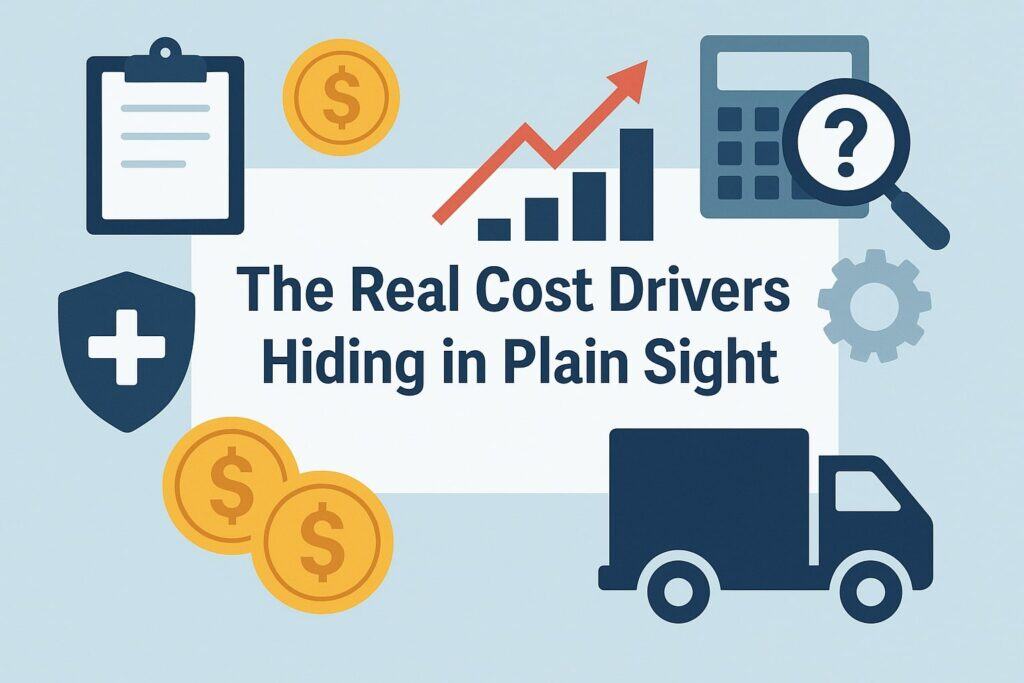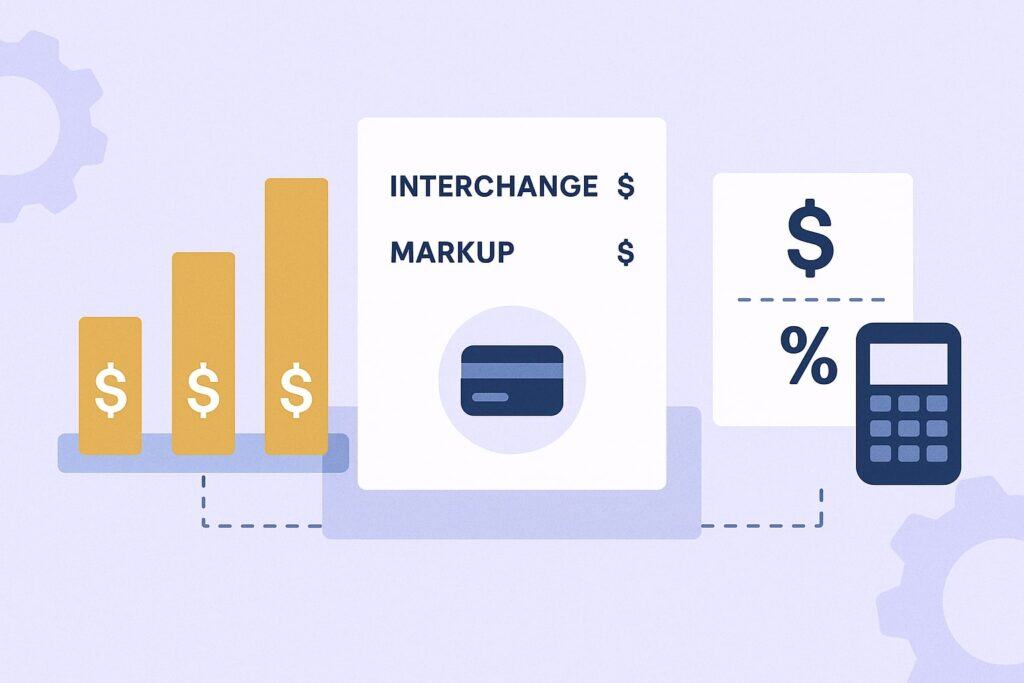
By alphacardprocess October 10, 2025
Small businesses often discover that merchant services cost far more than they expected. The bills look complex, the fee names are vague, and the pricing models are hard to compare. That combination makes merchant services feel opaque and expensive.
This comprehensive guide explains in plain language where the extra costs come from, how pricing really works, and what specific steps a business can take to stop overpaying. You’ll learn how to decode statements, choose the right pricing model, avoid junk fees, and negotiate like a pro.
Every section is written to be easy to follow, yet detailed enough to be practical. If you accept cards today or plan to start, use this article to benchmark your costs and implement a smarter, fairer merchant services setup.
The Real Cost Drivers Hiding in Plain Sight

The first reason small businesses overpay for merchant services is simple: the true cost drivers hide under layers of terminology. Every card sale has three cost components.
First is interchange, the wholesale fee set by card brands and paid to the cardholder’s bank. Second is assessments, small network fees collected by the brands themselves. Third is the processor markup, which is what your provider charges on top of wholesale.
Many statements blur these components, bundling them together into a single rate or using non-standard names that make apples-to-apples comparisons impossible.
Interchange changes by card type, entry method, and data quality. Rewards, corporate, and international cards typically carry higher interchange. Card-present sales with EMV contact or contactless tend to be cheaper than keyed-in or card-not-present sales.
Missing data like AVS or Level 2/3 fields can trigger downgrades, raising the effective rate. Meanwhile, assessments are usually predictable, but some providers re-label them or pad them through “network” or “regulatory” fees.
Finally, the markup varies by provider and pricing model; it’s where most negotiation happens. When a provider shows a blended number, you lose visibility into whether the problem is interchange, assessments, or markup. That opacity is a core reason many companies overpay for merchant services without realizing it.
Pricing Models Explained: Tiered vs. Interchange-Plus vs. Flat-Rate

Another major driver of overspending on merchant services is choosing the wrong pricing model. Tiered pricing sorts transactions into “qualified,” “mid-qualified,” and “non-qualified” tiers with bundled rates. It sounds simple, but tiers are defined by the provider and can change without warning.
A card keyed in without certain data might drop from qualified to non-qualified, nearly doubling your effective rate. Tiered pricing also makes it difficult to verify whether your actual interchange costs justify the tier you were assigned.
By contrast, interchange-plus pricing passes through the exact wholesale costs and adds a transparent markup—typically a fixed basis-point percentage plus a per-transaction fee.
Because you see the actual interchange categories, you can spot downgrades and fix root causes. Interchange-plus aligns the provider’s incentives with yours: if your transactions clear at lower-cost categories, you benefit immediately.
Flat-rate pricing, common with aggregators, can be cost-effective for very low monthly volumes or highly variable micro-sales, but it becomes expensive as tickets rise or as your sales scale.
For most growing small businesses, transparent interchange-plus pricing reduces waste and supports better optimization decisions. If you’re unsure which model you have today, ask for a written pricing disclosure and request an interchange-plus quote for a clean comparison on your merchant services.
The Hidden Fee Problem: Junk Charges That Inflate Your Bill

Small businesses routinely overpay for merchant services because of hidden or poorly explained fees. Common culprits include PCI non-compliance fees, monthly “regulatory” or “network” fees, annual fees, batch/settlement fees, monthly minimums, statement fees, and gateway or platform access fees that were never disclosed clearly.
Some providers even add both a “service” fee and a “support” fee, which often overlap. A handful create “optimization” or “maintenance” fees that sound legitimate but don’t reflect meaningful value.
The fix starts with a line-by-line audit. Request a recent statement in CSV or PDF and list every fee by name and amount. Confirm whether each fee is mandated by the card brands or is a provider add-on.
Verify whether gateway charges match the actual features you use, and whether your merchant services contract allows the provider to change these fees unilaterally. Challenge PCI non-compliance fees by completing your SAQ and closing any remediation items.
If you see duplicative network or regulatory fees, ask for them to be removed. Reducing junk fees doesn’t change interchange, but it directly lowers your effective rate and delivers immediate savings without changing your payment flow.
Equipment Traps: Leases, Long Terms, and Proprietary Locks
Hardware and software traps can lock a business into overpriced merchant services. Equipment leases are a prime offender: a $300 terminal can cost thousands over a multi-year lease with a non-cancelable term.
Proprietary gateways, closed terminals, or “semi-integrated” systems that only work with one processor can also force you to accept high markups because switching means replacing devices and retraining staff.
The same dynamic appears in embedded POS systems that require the provider’s gateway and add unavoidable platform fees.
To avoid these traps, prefer buy-not-lease where possible and choose processor-agnostic hardware. Look for terminals and POS systems that support standard integrations, EMV, NFC/contactless, and common wallets without locking you to a single back-end.
Ask for a hardware ownership cost breakdown, including warranties and replacement schedules. If your environment needs a gateway, confirm that it’s portable—i.e., you can take your transaction tokens and vault with you if you switch providers. That portability gives you leverage to negotiate fair merchant services pricing now and later.
Downgrades and Data Quality: The Quiet Rate Killers
Many merchants pay more than necessary because of downgrades—when a transaction fails to meet the criteria for a lower-cost interchange category and is routed to a more expensive one.
Card-not-present sales are especially vulnerable. Missing AVS results, late settlement, incomplete order information, or lack of Level 2/3 data for corporate/purchasing cards all trigger higher costs.
For B2B sellers, Level 2/3 data can materially reduce interchange on eligible transactions, but only if your gateway or ERP reliably passes those fields. Start by analyzing a month of transactions by interchange category.
Identify patterns: are many keyed transactions downgrading because they’re settled after the allowed window? Are corporate cards missing tax amount, PO number, or line-item details needed for Level 2/3? Does your POS prompt for AVS on keyed entries?
Implement guardrails—automatic prompts for AVS, nightly auto-batch by a fixed time, and required fields for B2B orders. Validate that your merchant services gateway supports Level 2/3 and that your staff understands which orders require those fields.
Reducing downgrades is one of the fastest ways to cut costs without changing volume, and it aligns well with transparent interchange-plus pricing.
Chargebacks, Fraud Tools, and the Cost of Weak Controls
Chargebacks don’t just claw back revenue; they create additional merchant services expenses. You can incur chargeback fees, higher dispute ratios, and eventually account monitoring or reserve requirements if your ratios exceed thresholds. Preventive tools reduce those risks, but you must balance cost and friction.
Essential controls include EMV acceptance in-store, 3-D Secure or equivalent authentication online for risky transactions, address verification (AVS), CVV checks, flexible velocity rules, and order review workflows that flag high-risk combinations (e.g., high ticket + international + mismatched AVS).
Strong documentation is equally vital. Publish clear refund and shipping policies, capture signed delivery or carrier confirmation for high-ticket orders, and respond promptly with complete evidence during disputes. Use alerts to intercept disputes early when feasible.
While fraud tools and alerts add line-item costs, they can lower your total cost of acceptance by preventing chargebacks and maintaining healthy ratios. A sound fraud stack also keeps your merchant services relationship stable, protecting your processing privileges and pricing.
Surcharging, Cash Discounts, and Compliance Pitfalls
Programs like surcharging and cash discounting promise to offset card costs, but doing them incorrectly can backfire. Rules vary by card type and jurisdiction, and implementation details matter. Incorrect signage, misapplied fees, or applying surcharges to debit can trigger fines, refunds, or provider termination.
Some third-party programs blend different fees together in ways that confuse customers and invite complaints. Even when allowed, poor execution harms conversion and lifetime value, offsetting any short-term savings on merchant services.
If you pursue these models, follow best practices. For surcharging, ensure you only surcharge eligible credit cards, cap the surcharge according to allowed limits, notify networks if required, and present the fee clearly at checkout before payment.
For cash discounting, set dual pricing correctly and display both cash and card prices transparently. Work with a provider that offers compliant tools, proper signage, and robust training.
If your customers are price-sensitive, consider dual pricing that keeps transparency high and pushes more digital wallet or debit acceptance paths that carry lower costs. The goal is not just to shift fees but to protect trust while managing merchant services expenses legally and ethically.
Statement Analysis: How to Read and Benchmark Your Costs
You cannot solve what you cannot see. Perform a quarterly statement analysis to benchmark your merchant services costs. Start with the effective rate: total fees divided by total processed volume. Break fees into three buckets—interchange, assessments, and markup.
If your pricing is interchange-plus, isolate the markup (basis points + per-item fees + monthly fees). If you’re on a tiered or flat plan, convert the totals into an effective rate and compare to an interchange-plus quote using your same volume, average ticket, and card mix.
Next, list all recurring fees (monthly, annual, gateway, PCI, statement, account minimums) and all per-occurrence fees (batch, AVS, retrieval, chargeback, account update). Identify outliers and any fees that appear under vague names.
Compare two consecutive quarters to spot creeping increases. Ask your provider to explain each fee on a recorded call or in writing. If they cannot substantiate a fee with a clear policy or a pass-through network charge, request removal or switch providers.
Build a simple spreadsheet that tracks your effective rate over time. With a few cycles, you’ll know immediately if your merchant services costs are trending the wrong way.
Negotiation Strategies That Actually Work
Negotiating merchant services is most effective when you present data and credible alternatives. Gather three written quotes with interchange-plus markups spelled out (e.g., +0.15% + $0.07).
Share your last two months of statements—redacted if needed—and ask each provider to price against your exact mix and average ticket. Require that all monthly and annual fees be listed, along with gateway or platform fees.
Explain that your decision will weigh transparency, portability of tokens and hardware, and service responsiveness, not just the headline rate.
When you receive proposals, normalize them. Convert exotic markups (e.g., multifactor or blended “optimization” fees) into basis points and per-item amounts so you can compare apples-to-apples. Ask for rate lock language for at least 24 months on the markup.
Request a no-ETF (no early termination fee) clause and a no liquidated damages clause. Require token portability and a PCI SAQ support plan at no or low cost. If a provider insists on tiered pricing, treat that as a red flag and request an interchange-plus option.
During renewal, use your benchmark spreadsheet to show improvements you’ve implemented (Level 2/3, AVS usage, auto-batch) and ask for a markup reduction commensurate with your lower risk and cleaner data. Persistence and structure win negotiations for merchant services.
PCI Compliance and the Cost of Non-Compliance
PCI non-compliance fees are entirely avoidable, yet many small businesses still pay them. Providers assess monthly penalties if you haven’t completed your PCI SAQ or remediated issues found in scans.
Beyond direct penalties, non-compliance increases your risk of a data compromise, which can lead to forensic audits, fines, card reissuance costs, and reputational damage. Ironically, merchants sometimes avoid the SAQ because they fear it’s complicated—then pay recurring fees indefinitely.
To reverse that pattern, adopt a “compliance first” posture. Complete the correct SAQ based on your environment (e.g., SAQ A for fully hosted e-commerce, SAQ P2PE for validated point-to-point encryption solutions).
Use tokenization, P2PE or E2EE terminals, and gateway-hosted fields to reduce your PCI scope. Schedule quarterly scans if required, and assign a single owner to track remediation tasks to closure.
Ask your provider whether they include SAQ assistance or a compliance portal at no extra charge. Once you complete PCI and maintain it, ask the provider to remove any non-compliance fees going forward. Maintaining PCI lowers your risk, protects customers, and reduces unnecessary merchant services costs.
B2B Optimization: Level 2/3 Data and Corporate Card Best Practices
If you sell to other businesses or governments, Level 2 and Level 3 data optimization can materially reduce interchange. Level 2 typically requires additional fields such as tax amount and merchant tax ID. Level 3 adds line-item details like SKU, quantity, unit cost, freight, and duty.
Not every transaction qualifies, but when they do, the savings are significant. The catch is operational: your systems must capture and transmit these fields reliably for eligible cards, and your staff needs to understand when to apply them.
Start by mapping your order flow. Where are tax and PO numbers captured? Does your ERP or invoicing system pass line items to the gateway? Can your gateway dynamically identify commercial, purchasing, or corporate cards to request Level 2/3 prompts?
Work with your merchant services provider to enable these features and test a subset of transactions each week, verifying that interchange categories improve.
Document a playbook: which orders qualify, what data is required, who validates, and how exceptions are handled. Treat Level 2/3 as a repeatable operational process, not a one-time toggle. Over a quarter, you should see a sustained reduction in effective rates for B2B acceptance.
Omnichannel Consistency: In-Store, Online, Invoicing, and Mobile
Small businesses increasingly sell across channels—brick-and-mortar, e-commerce, invoicing, subscriptions, and mobile. Inconsistent setups across channels cause fragmented merchant services costs.
You might have EMV devices in-store with low costs, but a legacy e-commerce gateway charging high monthly fees and per-transaction surcharges.
Or your invoicing tool might route payments through an aggregator at flat rates far above your negotiated interchange-plus plan. Subscriptions might run on a separate platform with higher chargeback rates due to poor dunning and retry logic.
The fix is architectural. Inventory all acceptance points and map them to providers, gateways, and fee schedules. Consolidate where possible under a unified gateway or platform that supports multiple channels with consistent pricing, token vaulting, and account updater services.
Align fraud rules by channel, adding 3-D Secure for higher-risk online flows while keeping EMV and contactless front-and-center in store. Unify reporting so you can monitor total cost of acceptance across channels each month.
When your omnichannel stack is aligned, you pay only for what you use, and you gain leverage to negotiate better merchant services terms.
Practical 90-Day Plan to Cut Your Merchant Services Costs
To turn insight into action, follow this 90-day plan. Days 1–15: Gather three months of statements and compute your effective rate. Categorize every fee and identify non-negotiables (interchange/assessments) versus negotiables (markup, monthly fees, junk fees).
Days 16–30: Complete PCI SAQ, enable auto-batch, turn on AVS/CVV prompts, and verify that EMV/contactless is your default in-store. Audit your gateway fees and remove unused add-ons.
Days 31–45: For B2B, pilot Level 2/3 on a subset of corporate cards. For e-commerce, enable 3-D Secure for flagged risk segments and tune velocity rules.
Days 46–60: Solicit three interchange-plus quotes using your real volume and card mix; standardize proposals into basis points + per-item + monthly.
Days 61–75: Negotiate for rate-lock, no ETF, token portability, and transparent pass-through of network fees.
Days 76–90: Migrate channels you plan to consolidate, re-baseline your effective rate, and set quarterly statement reviews. This cadence builds durable savings and a resilient merchant services operation.
FAQs
Q.1: How do I tell if I’m overpaying for merchant services?
Answer: Start with your effective rate—total fees divided by total processed volume for a given month. If you see an effective rate materially above what you’d expect for your business model and average ticket, you’re likely overpaying.
For example, a card-present retailer with strong EMV usage might target an effective rate closer to the mid-to-high twos or lower depending on mix, while a card-not-present business often trends higher due to risk and interchange.
Next, look for tiered pricing terms like “qualified” and “non-qualified,” which often mask expensive downgrades. Check for PCI non-compliance fees, mysterious network fees, and monthly minimums.
If your statement uses blended rates with vague labels, ask for a conversion to interchange-plus so you can see real wholesale costs and the provider’s markup.
Run this analysis for two or three consecutive months to identify creeping fee changes. If you can’t get clear answers or documentation, that alone is a sign you’re overpaying for merchant services and should solicit alternative quotes.
Q.2: Is flat-rate pricing ever a good idea for small businesses?
Answer: Yes—flat-rate can make sense for very low monthly volume, micro-transactions, pop-ups, and side hustles where predictability and simplicity outweigh pure cost optimization.
It also works when you need instant onboarding and don’t want to provide detailed underwriting information. However, as your sales scale or your average ticket increases, flat-rate often becomes more expensive than interchange-plus.
You also lose visibility into downgrades and optimization opportunities like Level 2/3 data for B2B. If you start on flat-rate, set a trigger to reevaluate—say, once you process more than a set monthly volume or your average ticket rises above a threshold.
At that point, request an interchange-plus quote and compare your last month’s actuals under both models. Maintaining the flexibility to switch ensures you don’t overpay for merchant services as your business grows.
Q.3: What’s the fastest way to lower my costs without switching providers?
Answer: Begin with compliance and configuration: complete PCI to remove non-compliance fees, enable AVS/CVV checks, and set auto-batch to settle the same day to avoid late presentment downgrades.
If you accept B2B cards, enable Level 2/3 data for eligible transactions; even a partial rollout can lower average interchange. Review your gateway bill and remove unused features like unnecessary tokenization add-ons or duplicate account-updater products.
Ask your current provider to convert you from tiered or blended pricing to interchange-plus and to remove junk fees like statement or “regulatory” surcharges that don’t map to real assessments.
Document every change and compare your effective rate month over month. These steps often deliver immediate savings on merchant services without a migration.
Q.4: How do equipment leases and proprietary systems increase my total cost?
Answer: Equipment leases lock you into multi-year obligations where the total payments exceed the purchase price of the device by several multiples. Because the lease is typically separate from processing, you may owe the full lease even if you switch providers.
Proprietary or closed systems force you to keep a specific processor or gateway, limiting your leverage to negotiate better merchant services pricing. If changing processors means replacing your POS and retraining staff, you are less likely to switch—even when your fees climb.
To avoid those traps, buy hardware outright when feasible, choose processor-agnostic equipment, and ensure token portability. Before signing, ask vendors to confirm in writing that your devices and tokens will work if you later use another processor. Preserving portability protects your future negotiating power and lowers your long-term cost of acceptance.
Q.5: Should I use surcharging or cash discounting to offset fees?
Answer: These programs can reduce your out-of-pocket merchant services costs, but they carry compliance and customer-experience risks. If you choose surcharging, make sure it applies only to eligible credit cards, is clearly disclosed before payment, and follows caps and rules that may vary by jurisdiction.
Never surcharge debit. For cash discounting, present dual pricing transparently so customers understand the card price versus the cash price. Use signage, receipt notations, and POS prompts that align with current rules and card brand requirements.
Poorly implemented programs invite complaints, lost sales, or provider action. In many cases, improving your pricing model, eliminating junk fees, enabling Level 2/3, and tightening fraud controls deliver cleaner, lower-risk savings than aggressive surcharging.
If you move forward, partner with a provider that offers compliant tools, training, and documentation as part of your merchant services package.
Conclusion
Small businesses overpay for merchant services when costs are hidden, pricing models are mismatched, and operations leak value through downgrades, junk fees, and weak controls.
The remedy is a clear, systematic approach: insist on interchange-plus transparency, complete PCI to eliminate penalties, enable AVS/CVV and auto-batch, adopt Level 2/3 for B2B, and consolidate channels under a portable, processor-agnostic stack.
Negotiate markups with data in hand, ask for rate locks and no ETFs, and require token portability so you maintain leverage over time. Review your statements quarterly and track your effective rate like a vital KPI.
Do these things consistently, and your total cost of acceptance will fall—often quickly and without disrupting your checkout experience. You’ll gain durable savings, better dispute outcomes, and a payment foundation that scales.
Most importantly, you’ll move from confusion to control, turning merchant services from a frustrating expense into a well-managed, transparent part of your business.